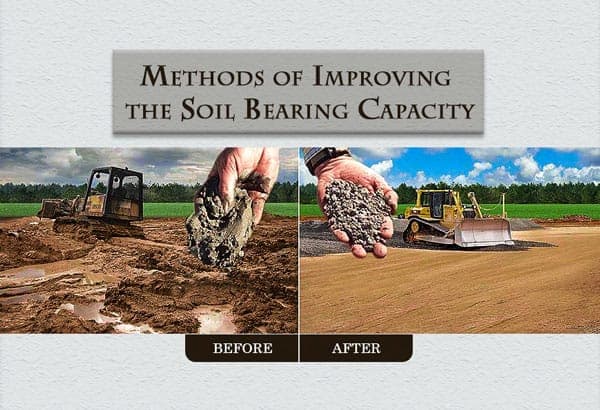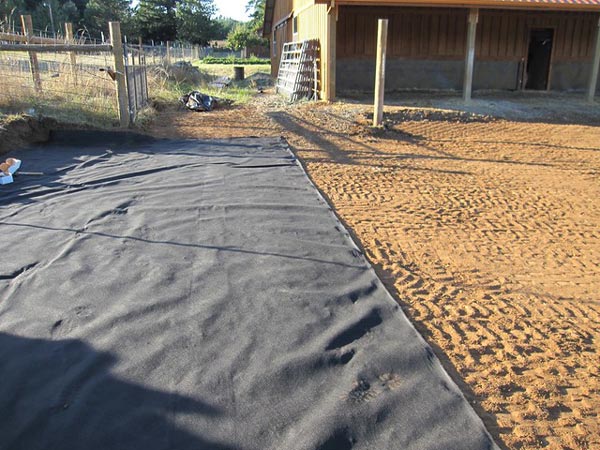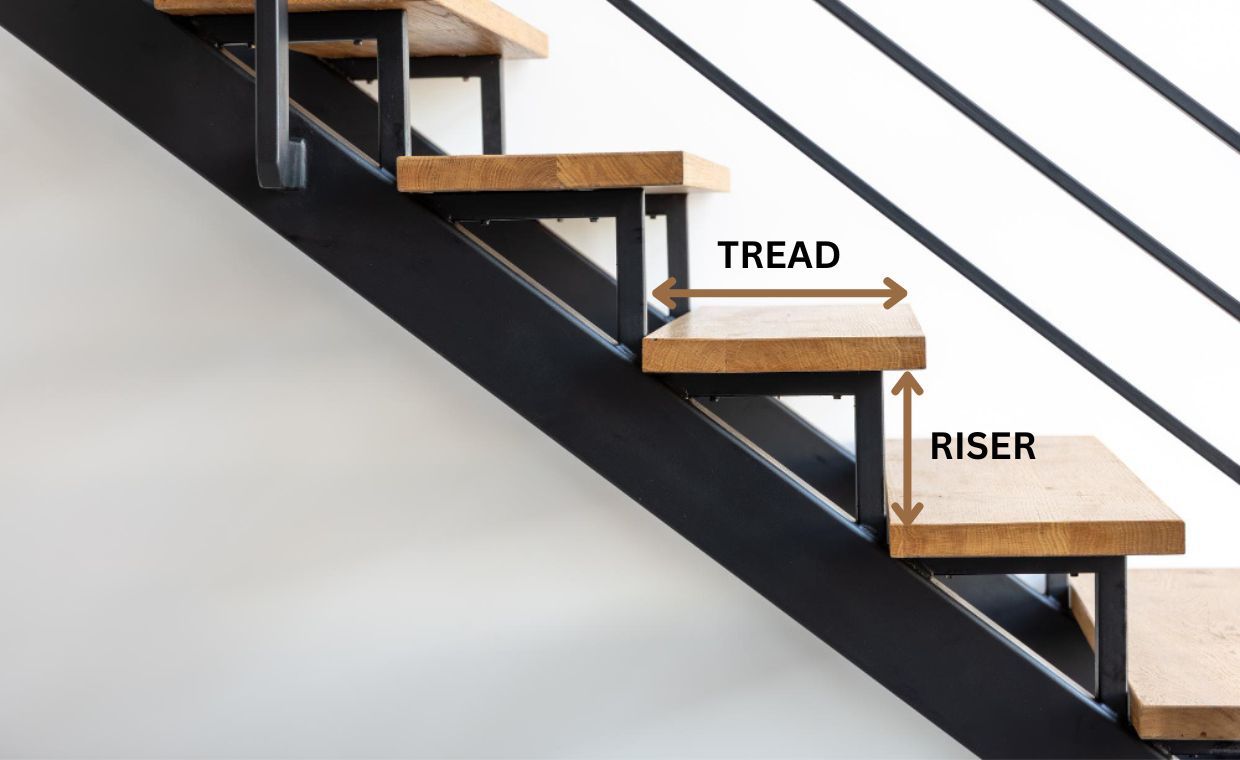
The term ‘Soil’ has various meanings which depends on the field in which it is considered. According to the ‘DR.B.C.Punmia, Ashokkumar Jain, Arunkumar Jain’ (Authors of Soil Mechanics and Foundations), to an agriculturist the soil is the substance existing on earth’s surface which grows and develops plant life.
To a geologist, soil is the material in the relatively thin surface zone within which roots occur, and all rest of the layers are grouped under the term rock irrespective of its hardness.
To an engineer, the soil is the unaggregated or uncemented deposits of mineral or organic particles covering a large portion of earth’s layer. The knowledge of the use of soil extends into pre-historic times when man started construction for living and built roads for transportation.
To know the methods of improving the bearing capacity of the soil it is important to understand the concept of soil bearing capacity.
Definition of Bearing Capacity of Soil
The soil bearing capacity can be defined as the load carrying capacity of soil. It is maximum load per unit area which the soil or material in the foundation that can be rock or soil will support without settlement.
Soil bearing capacity can also be defined as the capacity of soil to carry the load coming from the superstructure. If the foundation soil is not capable of carrying load coming from the superstructure, the structure will collapse. Very often, a structure fails by an unequal settlement or differential settlement.
Also Read:
7 Important Requirements that the Foundation System should Meet
10 Important Criteria to Choose the Right Foundation for Your House
Factors Affecting the Soil Bearing Capacity
According to ‘P.C.Varghese’ (Author of Foundation Engineering Geotechnical Aspects), the various factors affecting the bearing capacity of soil are
01. Position of Groundwater Table:
- The rise in the water table below the foundation results in decreasing the soil bearing capacity.
- If the water table is at a depth greater than the base of the footing, there is no effect of water table on the bearing capacity.
- If the water table reaches the ground level, rising from a depth equal to or greater than the width of footing below the base of the foundation, the bearing capacity get reduced by about 50 per cent.
02. Relative Density of soil:
- The bearing capacity of soil increases with an increase in relative density of soil.
03. Width of Footing:
- The bearing capacity of soil is directly proportional to the width of the footing which means larger the area more will be soil bearing capacity.
04. Depth of Footing:
- An increase in depth of footing will result in an increase in the surcharge at the base level of foundation, leading to an increase in soil bearing capacity.
05. Unit Weight of Soil:
- The unit weight of soil varies for different types of soil.
- A soil with higher density will contribute to higher soil bearing capacity.
06. The Eccentricity of Load:
- The eccentric loading can result in effective dimensions of footing getting increased.
Sometimes the chances are:
- The required safe soil bearing capacity is not available at shallow depth.
- The safe bearing capacity is so low that the dimensions of the footings work out to be very large and uneconomical.
For, the safety of foundation and superstructure it is necessary to improve the soil bearing capacity.
Methods for Improving the Soil Bearing Capacity
According ‘Sushil Kumar’ (Author of Building Construction), the following methods are generally adopted to improve the bearing capacity of soils
01. By Increasing the Depth of the Foundation
- In most cases, the bearing capacity increases with the increase in depth due to increase in the confining weight of the overlying material.
- This method is not economical because of the cost of construction and load on foundation increases with an increase in depth.
- This method should not be used on silts where the subsoil material becomes wet as the depth increases.
02. By Increasing the Width of the Foundation
- By increasing the width of the foundation, the bearing area increases and the intensity of pressure decreases.
- This method has limited use as the width of the foundation cannot increase beyond a limit and has effect on cost.
03. By Draining the Soils
- The presence of water decreases the bearing capacity of the soil.
- The studies show that around 50 per cent of bearing capacity get lost in sandy soils due to the presence of excess water.
- Therefore, suitable drains should be provided in the foundation channel to drain off the excess water.

04. By Compacting the Soil
- soil compaction is a process by which the soil particles are artificially rearranged and packed together into closer state of contact by mechanical means in order to increase its dry density.
- The compaction process is complete with rolling, tamping or vibration on the field.
- The compaction of soil results in an increase in the soil bearing capacity.

Also Read:
Soil Compaction with Rammer
Soil Compaction with Sheepsfoot Roller
05. By Confining the Soil
- The use of sheet piles can confine the soil that prevents the soil movement effect under the action of load.
- This method is useful for sandy soil underlying shallow foundation.

06. By Replacing the Poor Soils
- The poor soil is first removed and then the gap is filled by superior materials such as sand, rubble stone, gravel or other hard material.
- First, the foundation trenches are excavated and then it is filled with hard materials.
07. By Grouting
- Grout is the mixture of water, sand and cement or lime. Grouting is the process in which material is injected into the soil under pressure to fill gaps/voids in the soil.
- In the soil with poor bearing capacity a sufficient number of boreholes are driven and then the grout is injected under pressure. Since it fills all cracks and gaps, it increases the bearing capacity of the soil.

08. By Soil Stabilization
- Soil stabilization is the process in which the soil is interchanged to enhance its physical properties.
- Stabilization can improve the properties of soil, thus increasing the bearing capacity of soil
- The material used in soil stabilization includes cement, lime and bitumen.

- The soil stabilization can be used on roadways, parking area, site development project, airports and many other situations where sub-soil is not suitable for construction.
09. By Chemical Treatment
- The chemicals like silicate of soda and calcium chloride with soil particles form a gel-like structure and develops into a compact mass. These chemicals when mixed with soil improve the soil bearing capacity.
- This chemical stabilization is used to impart additional strength to soft soils at a greater depth.
10. By Using Geotextiles
- Geotextiles are permeable fabrics which are used in road construction to improve the soil bearing capacity.

Summing up, the bearing capacity of soil is a maximum load per unit area which the soil can carry without yielding or displacement. Soil behaves in complex manner when loaded and tends to deform. When excessive load is transmitted to the soil by a structure, the settlement of the foundation takes place which can endanger the stability of the structure.
You cannot rest the foundation on a weak or poor soil. There are various methods for improving the bearing capacity of soil. The method you choose depends on the type of soil and the sub-soil conditions of construction site and type of project.
Must Read:
Importance of Topography & Soil Condition in Site Analysis
Signs of Foundation Problems in Your House



































